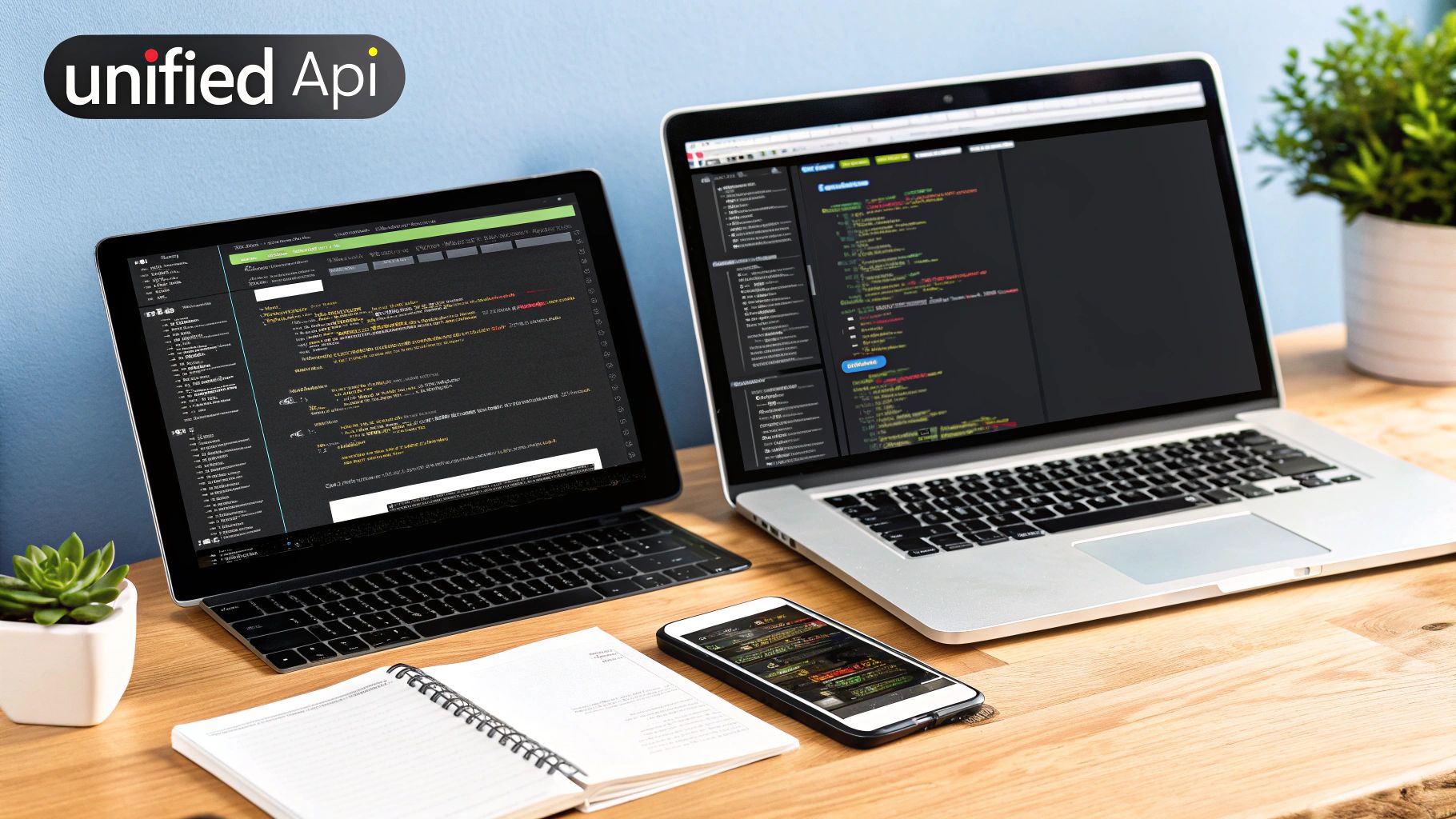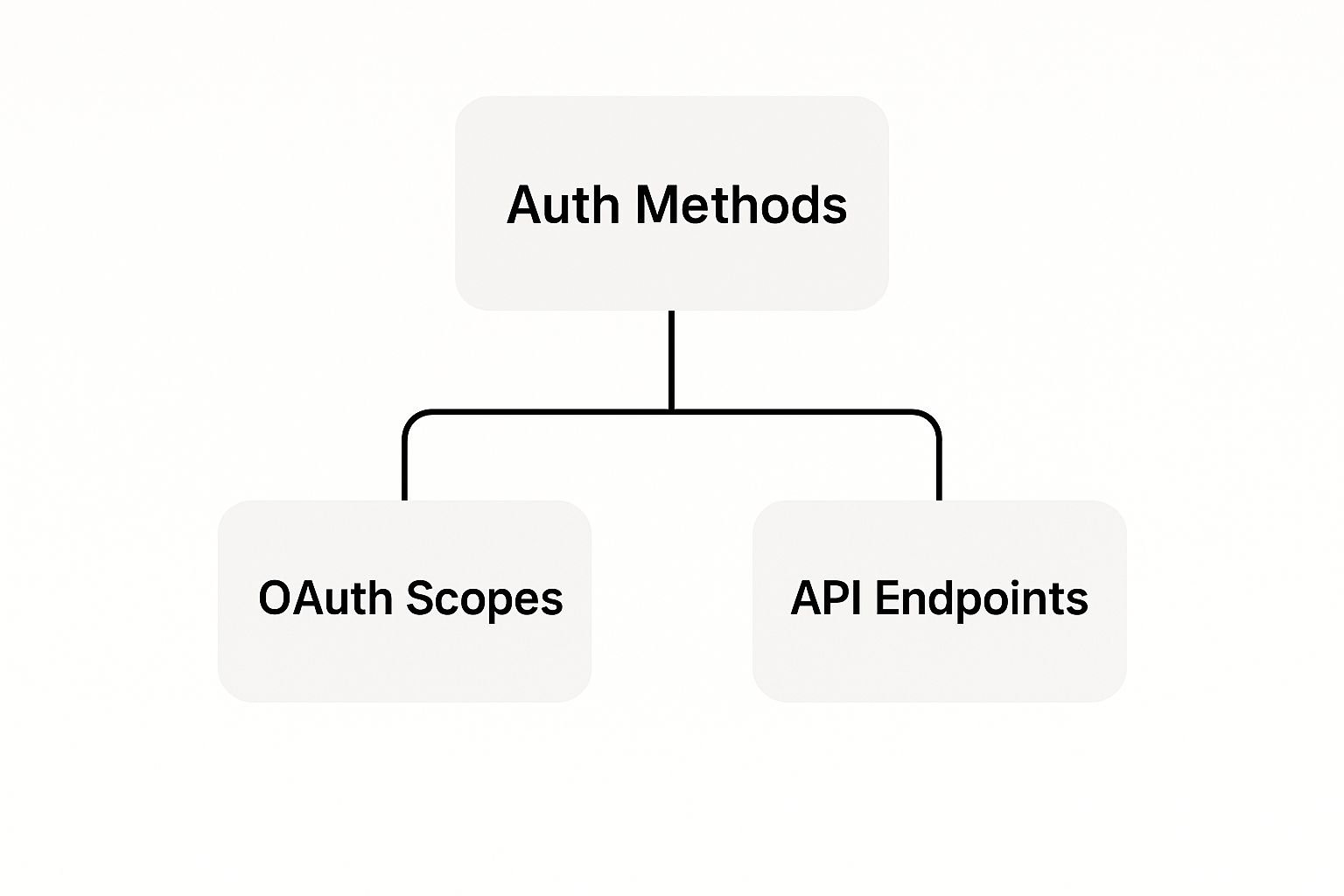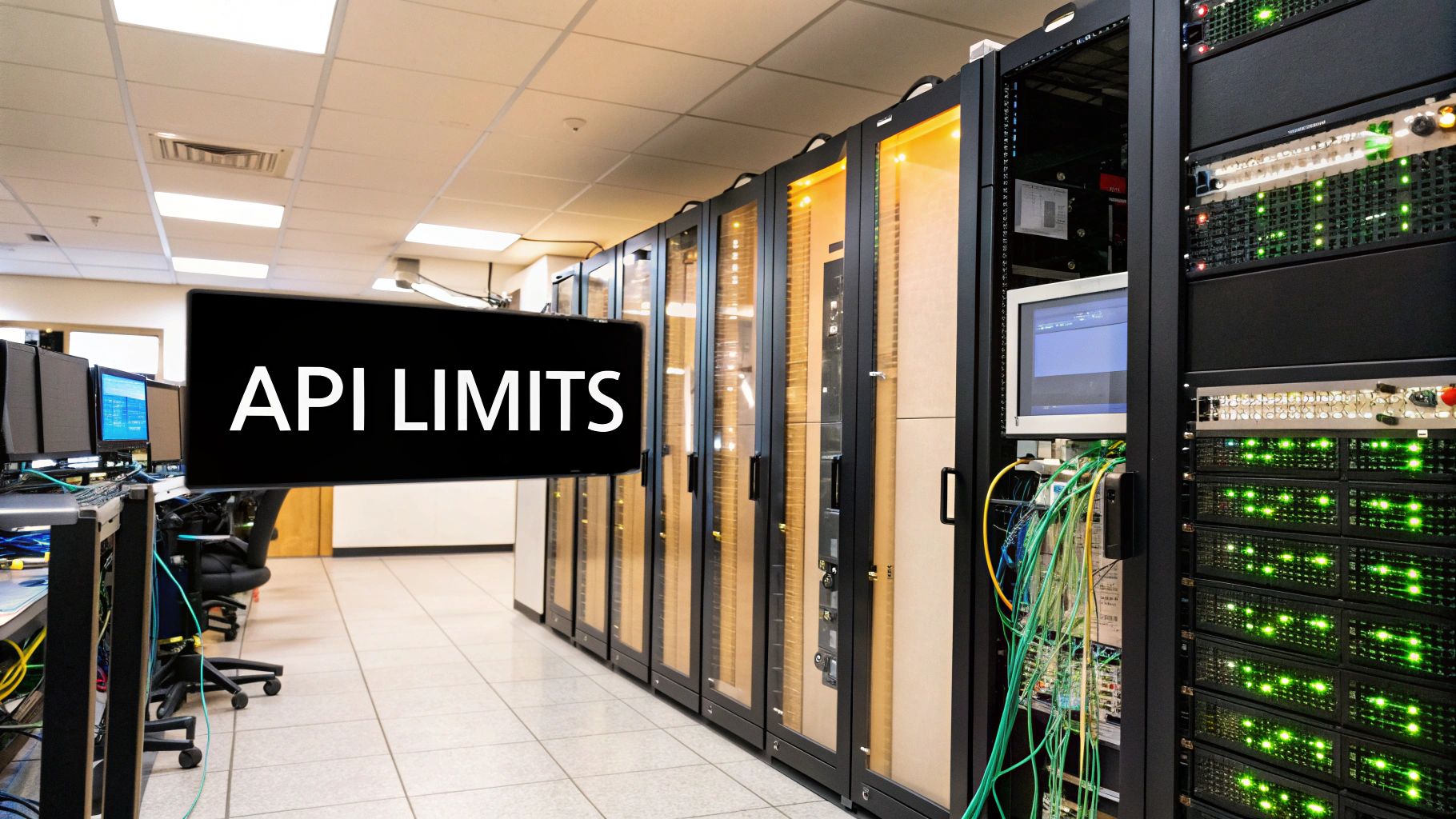At its core, a cross platform social media API is like a universal translator for developers. It provides a single, clean point of integration to manage a whole universe of social networks—think Facebook, X (formerly Twitter), TikTok, and more. Instead of wrestling with each platform's unique quirks, it standardizes everything into one consistent format.
This saves developers an incredible amount of time and frees up businesses to schedule content, pull analytics, and engage with their communities from one central dashboard.
Taming the Chaos of Multiple Social Platforms

Trying to manage a brand across every major social channel today feels like conducting an orchestra where every musician is playing from different sheet music. Each platform, from Instagram to LinkedIn, offers a unique audience, but it also brings its own set of technical headaches.
This leaves developers and marketers stuck in a fragmented reality. They have to deal with totally different APIs, unique data structures, and a frustrating maze of rate limits and authentication rules for every single network. That constant juggling act is a massive pain.
The Problem of Digital Fragmentation
Without a unified API, development teams are trapped in a cycle of building and maintaining dozens of separate integrations. This isn't just inefficient; it's a huge drain on resources. Every time a platform like X pushes an API update, developers have to drop everything to patch their code, pulling them away from building the features that actually matter.
This fragmentation causes some serious problems:
- Siloed Data: Your performance metrics are trapped inside each platform's little world, making it almost impossible to get a clear, big-picture view of how your campaigns are really doing.
- Wasted Development Time: Engineers burn countless hours writing the same boilerplate code over and over for each integration instead of focusing on innovation.
- Inconsistent Analytics: Trying to compare "engagement" across platforms is like comparing apples and oranges. Each network defines it and reports it differently, leading to messy, unreliable data.
The real challenge is simple: disconnected social media tools create disjointed data and messy workflows. That makes it incredibly difficult to measure true ROI or maintain a consistent brand voice.
The Scale of the Challenge
And this problem is only getting bigger. User behavior is constantly shifting. By 2025, the number of global social media users is expected to hit a staggering 5.45 billion, with the average person bouncing between nearly seven different platforms every month.
It's this exact cross-platform activity that makes a cross platform social media api so essential for bringing order to the chaos.
For anyone who’s felt this pain point and looked for a solution, checking out the best social media scheduling apps makes the need for centralized control crystal clear. A unified API tackles this problem at the root, transforming a chaotic mess into a streamlined, manageable system built for smarter social media management.
What Is a Cross Platform Social Media API?

Imagine you’re traveling the world with a single universal power adapter. Instead of lugging around a bag of different plugs for every country, you have one tool that connects your device to any outlet, no matter the shape or voltage. It just works.
A cross-platform social media API is that universal adapter for your application. It’s a single, elegant connection point that talks to multiple social networks like Facebook, TikTok, and LinkedIn on your behalf.
You don't have to build and maintain a dozen fragile, unique connections. Your app communicates with just one endpoint, and that endpoint handles all the messy translation work behind the scenes. It's a massive shortcut that makes your developers' lives infinitely easier.
The Two Pillars: Data Normalization and Unified Authentication
So, how does it pull off this magic trick? It all comes down to two core ideas that work in tandem. Grasping these concepts is the key to understanding why a unified API is such a game-changer for anyone building social media tools.
First up is data normalization. Think of each social network's API as speaking its own quirky dialect. A "retweet" on X is fundamentally different from a "share" on Facebook—not just in name, but in the underlying data structure. It’s chaos.
A cross-platform API acts as an expert translator. It takes the unique data "language" from every single platform and converts it into one common, standardized format. This means your application receives data that looks the same whether it came from Instagram or YouTube, so you don't have to write custom code to decipher each one.
A cross-platform API translates the chaos of many different data formats into a single, predictable language your application can easily understand. This process is essential for reliable cross-channel analytics.
The second pillar is unified authentication. Normally, connecting your app to multiple social networks means juggling a messy collection of API keys, access tokens, and separate login flows for each one. It's a huge headache for security and maintenance.
A unified API simplifies this entire process down to one secure set of credentials. You get a single key to access all connected platforms. Your application authenticates just once, and the unified API securely manages all the individual handshakes with each social network for you.
How This Simplifies Social Media Integration
When you put these two pillars together, the impact is massive. It completely changes how developers build and maintain social media integrations. In fact, businesses that use management tools built on these principles save an average of 6+ hours a week compared to manual posting.
By combining data normalization and unified authentication, a cross-platform social media API creates a powerful layer of abstraction. This buffer shields developers from the constant, frustrating updates and quirks of each native API.
This screenshot from Delivered Social does a good job of showing how different API solutions sit between management tools and the major platforms themselves.

The key takeaway is that these tools act as an intermediary, but a true cross-platform API takes it a step further by standardizing the connections themselves.
This unified approach brings some serious benefits to the table:
- Drastically Reduced Complexity: Your team only needs to learn and integrate with one API. That means less code, less confusion, and a much shorter development cycle.
- Effortless Maintenance: When a platform like Facebook updates its API (which happens all the time), the unified API provider handles the changes. Your integration stays stable without you lifting a finger.
- Launch Your Product Faster: Instead of spending months building individual connections, you can plug into multiple platforms in a fraction of the time. Get your product in front of users, fast.
Ultimately, a cross-platform API is the foundation for building modern social media tools, streamlining everything from scheduling to analytics. To see how this applies to content creation, you can dive deeper into the concept of a unified social posting API and how it powers today’s best scheduling tools.
How Unified Social APIs Are Architected
To really get what makes a cross-platform social media API tick, you have to look under the hood. These systems aren't just simple plugs; they're clever architectural solutions built to tame immense complexity. The real magic is in the design patterns that turn the chaos of dozens of APIs into one clean, simple experience.
Most unified APIs today are built on one of two dominant patterns: the API Gateway or the Aggregator model. Knowing the difference between them shows you the engineering trade-offs that go into building a tool you can actually rely on.
The API Gateway Pattern: A Smart Receptionist
Think of an office building with fifty different companies, each on its own floor with a unique security protocol. If you had to visit them all, you'd need a different badge and a new set of directions for every single one. It would be a logistical nightmare.
An API Gateway is like a smart, central receptionist in the main lobby. You show up with one ID (your API key), tell them who you're there to see (which social network endpoint you need), and they handle everything else. They route your request to the right floor, translate it for that company's specific rules, and bring the response straight back to you.
Technically speaking, the API Gateway is a single entry point for all your requests. It handles critical jobs like authentication, rate limiting, and routing your calls to the correct downstream service—whether that's the API for Facebook, TikTok, or LinkedIn.
This model is fantastic for real-time access because it's a direct pass-through. Your request goes in, gets routed, and the response comes back immediately without being stored. The biggest win here is low latency, as the gateway doesn't add much processing overhead. It's a lean, efficient traffic cop for your API calls.
The Aggregator Model: A Central Warehouse
Now, picture a totally different setup. Instead of a receptionist, imagine a massive central warehouse that partners with every company in the building. This warehouse is constantly getting shipments (data) from each company, unboxing everything, standardizing it, and organizing it on neat, clearly labeled shelves.
When you need something, you don't go to the individual companies anymore. You just head to the warehouse, where everything is already sorted and waiting for you in a consistent format. That's the core idea behind the Aggregator pattern, sometimes called the Federation model.
An Aggregator API does more than just route requests. It proactively pulls in, processes, and stores data from all the different social networks. It crunches all this messy information into a single, unified data model before you even ask for it. When your app makes a request, it’s querying this pre-aggregated, standardized dataset—not hitting the live social media APIs directly.
The Aggregator model shifts the hard work from request time to ingestion time. It does the heavy lifting of data normalization and storage upfront, giving your application a highly consistent and predictable data source to work with.
This approach is incredibly powerful for analytics and digging into historical data. Since the information is already collected and standardized, you can run complex queries across multiple platforms without worrying about the real-time latency or rate limits of the source networks. The trade-off, of course, is that the data might not be up-to-the-second real-time, since there's a small delay while the aggregator ingests it.
The infographic below shows how a unified system has to manage all the different authentication methods and endpoints, which is a core challenge for both architectural models.

This diagram breaks down the relationship between authentication, scopes, and specific API endpoints—all of which a unified architecture must juggle seamlessly for every platform it connects to.
Choosing the Right Architecture
So, which one is better? It all comes down to the job you need to do.
To help clarify the trade-offs, here’s a quick comparison of the two patterns.
API Gateway vs Aggregator Pattern Comparison
| Attribute | API Gateway Pattern | Aggregator/Federation Pattern |
|---|---|---|
| Primary Use Case | Real-time actions (e.g., posting, commenting). | Analytics, historical data, and complex queries. |
| Data Freshness | Real-time. Data is fetched directly from the source. | Near real-time. A slight lag due to ingestion process. |
| Latency | Low. Acts as a lightweight proxy. | Higher on ingestion, but very low for queries. |
| Complexity | Lower initial complexity; complexity is on the client. | Higher upfront complexity for ingestion and storage. |
| Reliability | Depends on the uptime of the source APIs. | More resilient; can serve data even if a source API is down. |
| Data Consistency | Data formats can vary between sources. | High. Data is normalized into a single, unified model. |
An app that needs to publish a post right now is a perfect fit for the low-latency API Gateway. On the other hand, a tool built for deep social listening and trend analysis would be much better off with the robust, pre-processed data from an Aggregator.
In reality, many modern unified APIs use a hybrid model, blending the strengths of both. A crucial concept for building these responsive systems is understanding event-driven programming, because at their core, social interactions are all about events. No matter the pattern, solid engineering is non-negotiable. You can learn more about those fundamentals in our guide to REST API design principles.
The Business Case for a Unified API Strategy
Let's move past the technical diagrams for a minute. The real magic of a unified API isn't just in the clean code—it's in the direct, measurable impact it has on your business. Adopting a cross platform social media API isn't merely an elegant engineering choice; it's a strategic move that delivers huge returns in efficiency, data quality, and the insights that give you a competitive edge.
When you consolidate all your social connections through one pipeline, you take social media management from a chaotic, resource-draining headache and turn it into a streamlined, strategic asset. This shift creates value for everyone, from your dev team all the way up to the C-suite. The whole business case really boils down to three core benefits that build on each other to drive growth.
Skyrocket Development Efficiency
The first thing you'll notice is a massive boost in how fast your team can move, coupled with a sharp drop in costs. Without a unified API, your engineers are stuck building and babysitting a separate, fragile integration for every single social network. And this isn't a one-and-done job—it's a perpetual maintenance nightmare.
Every platform’s API is in a constant state of flux. That means your developers are constantly being pulled away from building your actual product to patch broken connections and put out fires. A unified API puts a stop to all of that.
With a single integration point, you radically accelerate your product’s time-to-market. Instead of spending months building foundational plumbing, your team can integrate with multiple platforms in days, freeing up resources to focus on features that deliver real customer value.
This newfound efficiency hits your bottom line directly. You slash development overhead, minimize ongoing maintenance bills, and can jump on market opportunities way faster. Adding a new social network is no longer a quarter-long project; it becomes a simple configuration change.
Achieve True Data Integrity
Connecting to each platform individually creates data silos, and that means you’re stuck with inconsistent, messy information. Trying to compare a metric like "engagement" or "reach" across platforms is often a fool's errand because each network defines and reports them differently. You’re left with unreliable analytics, making it nearly impossible to measure the true ROI of your social media efforts.
A unified cross platform social media API fixes this by acting as a normalization engine. It takes each platform's unique metrics and translates them into a standardized, consistent format.
Suddenly, you can actually compare apples to apples. You get a clean, reliable dataset that gives you a complete picture of your performance across every channel. This data integrity is the bedrock of trustworthy analytics, empowering you to make confident, data-driven decisions about your social strategy.
Unlock Deeper Strategic Insights
Once you have clean, unified data, you unlock a whole new level of strategic analysis that's simply out of reach with fragmented information. A complete view of your social data allows for powerful social listening and competitive analysis. You can track brand mentions, analyze sentiment, and spot emerging trends across the entire social ecosystem from one central dashboard.
This is where the real strategic value shines. For instance, recent API usage data shows a fascinating shift: while Instagram profile scraping is still common, API calls for TikTok video transcripts have skyrocketed to 3.82 million with a 99.99% success rate. This points to a huge move toward analyzing the actual spoken content in videos—an insight you'd completely miss without a cross-platform view. To see what else the data revealed, you can explore the full analysis of over 10 million API calls.
Think about a simple task, like tracking a campaign's performance.
- Without a Unified API: You’re pulling separate reports from X, Instagram, and TikTok. Then you're stuck in spreadsheet hell for hours, trying to stitch together messy data and manually calculate some vague sense of overall performance.
- With a Unified API: You make one API call. In seconds, you get standardized performance data from all three platforms in a clear, aggregated report showing total reach, engagement, and conversion rates for the whole campaign.
This capability transforms your social data from a confusing liability into your most valuable strategic asset, giving you the clarity needed to outmaneuver competitors and win your market.
Choosing Your Path: Build Versus Buy

So, you see the massive potential a unified API holds. Now comes the big question: Do you roll up your sleeves and build it yourself, or do you partner with a specialist and buy a ready-made solution? This isn't just a technical decision. It's a strategic one that will shape your budget, roadmap, and where your team spends its time for years to come.
Each path comes with its own set of trade-offs. Building a cross-platform social media API from the ground up gives you absolute control. You can shape every last detail to your exact needs. But that freedom comes at a steep price—a huge, ongoing investment in a dedicated engineering team, complex infrastructure, and a never-ending cycle of maintenance.
The "buy" route, on the other hand, is all about speed, expertise, and predictable spending. By going with a commercial provider, you hand off the entire headache of API maintenance. This frees up your team to build the features that actually matter to your customers, instead of constantly fighting fires from unpredictable platform changes.
The In-House Build: A Long and Winding Road
Deciding to build your own unified API is a bit like choosing to build your own power plant instead of just plugging into the city grid. Sure, you get total control, but you're suddenly on the hook for everything—from the initial construction to daily upkeep and every emergency repair.
And the initial development is just the tip of the iceberg. The real monster is the relentless, soul-crushing maintenance. Social media platforms are notorious for changing their APIs, often with little to no warning. A single update from TikTok or a policy shift from LinkedIn can shatter your integration, forcing your engineers to drop everything and scramble for a fix. This reactive cycle drains resources, kills momentum, and suffocates innovation.
The Commercial Solution: Accelerating Your Vision
Opting for a commercial solution is like plugging into that city grid. You get instant, reliable power without the astronomical upfront cost or the long-term maintenance nightmare. These providers have entire teams that do one thing and one thing only: keep their unified API humming along smoothly, no matter what the platforms throw at them.
This approach completely changes the game for your development process. Instead of your team being bogged down for months building foundational plumbing, they can integrate multiple social networks in just a few days. It slashes your time-to-market and turns a massive, unpredictable capital expense into a simple, manageable operating cost.
A third-party unified API provider absorbs all the complexity of API maintenance, freeing your team to focus on innovation and shipping value to your users. It’s a strategic move to accelerate growth and sidestep a mountain of technical debt.
To really get a feel for this, it helps to see how it plays out in the real world. For example, looking into a SocialPilot API alternative can highlight the immediate advantages of a pre-built, professionally managed integration.
Comparing Build vs. Buy: A Practical Framework
Let's break down the decision with a clear, side-by-side look.
| Factor | Building In-House (Build) | Using a Provider (Buy) |
|---|---|---|
| Upfront Cost | Very high (salaries, infrastructure, development). | Low (a simple subscription or setup fee). |
| Time-to-Value | Slow (think months, or even years, to stabilize). | Fast (often ready to integrate in hours or days). |
| Ongoing Maintenance | Extremely high (needs a dedicated team on standby). | Zero (handled entirely by the provider). |
| Expertise Required | Deep, specialized knowledge of multiple APIs. | Minimal; you only need to learn one unified API. |
| Scalability | You build it, you manage it, you pay for it. | Handled by the provider; scales as you grow. |
| Focus | Diverts engineering talent from your core product. | Keeps engineers focused solely on your core product. |
In the end, while the idea of total control is tempting, the cold, hard realities of cost, time, and the relentless upkeep make buying the far more strategic choice for most companies.
A Few Common Questions
Diving into social media integrations always brings up a few questions. Let's clear up some of the most common ones you might have about using a cross platform social media api.
What's the Single Biggest Headache of Juggling Multiple Social Media APIs?
Hands down, it's the sheer inconsistency. Every single platform plays by its own rules. You've got different authentication methods, unique rate limits, completely different data structures, and a whole dictionary of error codes to learn for each one.
What does that mean for you? It means writing and maintaining a separate, custom-built integration for every single network. It's a massive drain on time and money, and it’s a fragile system that breaks every time a platform decides to update its API. A cross-platform API smooths over all these jagged edges, giving you one clean, predictable interface to work with. The development hours you save are immense.
How Does a Cross-Platform API Deal with Rate Limiting?
A good cross platform social media api is like a smart traffic cop for your requests. It manages all the different rate limits behind the scenes, so you don't have to. It uses a clever system to pool and pace your API calls, making sure you stay within each network's specific limits without you ever lifting a finger.
So, if your app suddenly sends a flood of posts, the API will automatically queue or slow them down just enough to keep the social networks happy. This prevents you from getting blocked or running into errors, creating a far more stable and reliable connection than you could ever manage by hand.
Think of a unified API as an intelligent buffer between your application and the chaos of multiple social networks. It automatically enforces the rules for you, preventing traffic jams and keeping your data flowing smoothly.
Is It Secure to Use a Third-Party Unified Social Media API?
Absolutely, as long as you partner with a provider that takes security seriously. The best unified API services rely on industry-standard protocols like OAuth 2.0. This is a huge deal because it means your application never directly handles or stores sensitive user passwords or credentials.
On top of that, all data should be encrypted with HTTPS while it’s in transit. Before you commit to any service, do your homework. Dig into their security documentation, read their data privacy policies, and check for compliance with regulations like GDPR. Make sure their standards are as high as yours.
Ready to stop wrestling with individual social media integrations and start building faster? With Late, you can connect to seven major platforms through a single, reliable API in under 15 minutes. Streamline your development, eliminate maintenance headaches, and ship your product faster by visiting https://getlate.dev to get started for free.